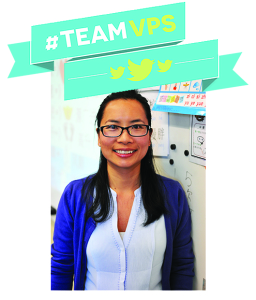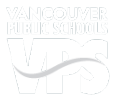Global competence at Fort Vancouver High School
Next fall, Fort Vancouver High School will debut its Center for International Studies. The school-wide program will enable students to work toward developing global competency as they learn about world issues and how to have a positive impact. The school is part of the Asia Society’s International Studies Schools Network, joining more than 30 other schools in working to develop globally competent, college-ready students.
With the launch of the center, the school also will offer American Sign Language, French, Mandarin and Spanish classes.

Learn more about Mandarin Immersion teacher Wen-Shun (aka Kate) Chen.
Wen-Shun Chen’s Franklin Elementary classroom looks like many other elementary classrooms in Vancouver Public Schools. Clusters of desks. Brightly colored charts. Student work dotting the walls. But unlike most other classrooms, here the signs are written in Chinese characters. Conversations flow from the second-graders and from Chen in Mandarin, not English.
To an untrained ear, the students, diverse in ethnicity, sound fluent. And after almost three years of studying Mandarin, they nearly are.
The Foreign Service Institute of the U.S. Department of State estimates that learning Chinese can require some 2,200 class hours for native English speakers to achieve proficiency. Students in Franklin’s Mandarin Immersion Program are on their way.
Before Mandarin Immersion debuted at the kindergarten level in fall 2009, that notion might have seemed unlikely. But with the inaugural class poised to enter Jason Lee Middle School next fall and a growing Mandarin Immersion student population, it is reality for some 230 students.
The model
The district’s strategic approach to immersion education begins in kindergarten, with 90 percent of the instruction in Mandarin and 10 percent in English. As students advance to higher grades,the ratio gradually becomes 50 percent Mandarin and 50 percent English.
The same model, with Spanish rather than Mandarin, also is used in the immersion program at Harney Elementary School. Established in 2008 with two kindergarten classes, the Spanish Immersion Program now serves 330 students at both Harney and McLoughlin Middle School.
A third Vancouver elementary school, Sarah J. Anderson, also offers Spanish instruction. The Spanish/English Dual Language program began in September 2005 with kindergarten and first-grade classes’ learning time split evenly between English and Spanish instruction. Those who have continued in the program beyond Anderson now attend Gaiser Middle School or Fort Vancouver High School. In total, there are 450 Dual Language students.
Moving up the scale
Familiarity with Spanish or Mandarin isn’t a prerequisite for any of the three programs. Though some students do speak the languages with varying proficiency, many have little or no knowledge of them. Says second-grader Molly Jung, who knew only a handful of numbers in Mandarin before starting the program as a kindergartener, “Everyone can try to speak a new language, and they can get better at it.”
Older students agree. Across town at Gaiser Middle School, students are enthusiastic about the Spanish/English Dual Language program in which they’ve participated since kindergarten.
One says that the process of learning Spanish is “like baby steps. You do the alphabet, then you do sentences and syllables. Then you work on grammar. You just keep moving up the scale.”
Says first-grade Spanish Immersion teacher Vicki Campos, “It is an exciting opportunity to observe students grow and learn a second or sometimes a third language.”
Global economy
Learning another language can have many benefits, in addition to fluency. Research has shown that bilingual students generally demonstrate greater academic gains and develop cultural literacy, as well as enhanced cognitive skills.
The Gaiser middle-schoolers see the potential implications of bilingualism for their career paths. “In my future, it’s going to open up a whole lot more doors. I can be more successful, and I can have better opportunities,” says Gabriela Garcia, who is considering becoming a professional interpreter.
Leap of faith
But the process of implementing K-12 instruction in another language hasn’t always been straightforward. Scaling up these programs presents challenges such as staffing. Laura Dilley, who became Franklin’s principal in the second year of the program, said that it has been difficult to find teachers, but that the school has been fortunate to hire high-quality teachers who meet state requirements.
Moreover, assessing students, selecting materials and aligning them to standards require effort and collaboration among all staff members.
Parents also encounter their own challenges. “There’s a little leap of faith that people have to take with putting their child in an immersion program,” Dilley says. Some parents may be unable to assist with homework in a language they don’t speak or understand. But the risk can pay off, especially for students who begin their studies in elementary school. “Within a public school arena, to be providing an immersion program or any second language is a gift,” Dilley adds.
And what a gift it is. According to one Gaiser sixth-grader, learning another language is “like this whole new world opening up to me. … It blows my mind.”
